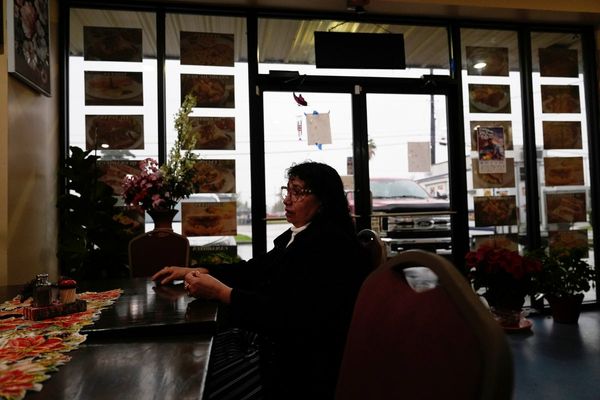The US president, Donald Trump, signed a secret directive on August 8 authorising the Pentagon to use military force against some Latin American drug cartels. To longtime observers of US foreign policy in the region, his directive only came as a partial surprise.
During his most recent presidential election campaign, Trump proposed bombing Mexico – although, amid the flurry of claims and promises, this extreme posture almost went unnoticed. And Mexican national security analysts have been warning for the past few years that use of US military force against Mexico is becoming increasingly likely.
On his first day back in office, Trump signed an executive order designating cartels and some other criminal groups “foreign terrorist organisations”. For past US administrations, such a designation has often acted as a prelude to – and partial justification for – violence.
Trump’s executive order defined cartels as a “national security threat beyond that posed by traditional organised crime”. This, it added, is due to the cartels’ work with international networks, their complexity and engagement in insurgency and asymmetric warfare, and their “infiltration” of governments in the western hemisphere.
In its report on Trump’s secret directive, the New York Times highlighted how the unilateral use of military force in Latin America would represent a dangerous escalation in the region.
In the past, the US has often presented its use of military force against the cartels as support for law enforcement there. It has also relied on collaboration with local governments and militaries to conduct joint operations.
Brian Finucane, a former legal adviser at the US State Department, noted in the same New York Times article that any use of force would encounter domestic constraints in Washington. It would need congressional authorisations, and the US government is formally banned from attempting assassinations. This ban could only be circumvented, Finucane argued, in cases of self-defence.
However, at least since the 1980s, the ban on assassination has rarely constrained US foreign policy. The so-called “war on drugs” of successive administrations has often blended overt and covert uses of force, culminating in the killing of prominent drug traffickers.
Justifying assassination
The use of force and assassination featured in the first war on drugs, declared by then-US president Richard Nixon in 1971. Journalists working on the Watergate scandal, an investigation into the administration’s involvement in a break-in at the Democratic National Committee headquarters in Washington, revealed that Nixon and his assistants had considered using hit squads and the assassination of 150 leading drug traffickers.
But the self-defence exception first emerged under the administration of Ronald Reagan (1981–1989). The CIA’s then-director, William Casey, and its legal counsel, Stanley Sporkin, both argued that the ban on assassinations did not apply in cases of self-defence. Their argument found support in an administration that was developing a rhetoric and policies to pre-empt terrorism, similar to those established in the aftermath of 9/11.
In 1989, early in the George H.W. Bush administration, this precedent was enshrined in a memorandum of law: the Parks Memorandum. This stated that overt or covert uses of force ordered by the president in self-defence would not constitute assassination if they targeted “combatant forces of another nation, a guerrilla force or a terrorist, or other organisations whose actions pose a threat to the security of the US”.
By this time, drug trafficking had replaced terrorism as a key security concern in the US, and Medellín Cartel leader Pablo Escobar was enemy number one. In April 1989, the CIA established a counter-narcotics centre, and the National Security Council soon started working on a policy review on how to deal with drug traffickers.
Assassination and the use of force emerged as clear policy options. William J. Bennett, then chief of the Drug Enforcement Administration (DEA), was a strong advocate of going after narcotraffickers. Bennett seemed to support the use of hit squads when he stated that same year: “We should do to the drug barons what our forces in the Persian Gulf did to Iran’s navy [during the Iran-Iraq war in the 1980s].”
Bush Sr also went back to another precedent set under Reagan. Starting in the mid-1980s, the Reagan administration had argued that a “marriage of convenience” had emerged between terrorists and drug traffickers. “Narcoterrorism”, then-secretary of state George Shultz suggested in 1987, should be considered a “shadow war”.
In this shadow war, assassination was seen as an available option – with some in the Bush Sr government proposing that if the ban on assassination did not apply to terrorists, it should not apply to drug traffickers either. Increasing violence by the Medellín Cartel at the time, alongside the Parks Memorandum and the administration’s declarations that cartels posed a national security threat, meant overt or covert use of force could be legitimised against the drug gangs too.
This became the legal rationale behind the so-called “kingpin strategy”, which involved the DEA, CIA, US armed forces and their local allies targeting and often killing drug lords and narcotraffickers. This included the leaders of the Medellín and Cali cartels. Escobar, for example, was killed by Colombian special forces in 1993, with extensive training and intelligence support from the US.
Covert and overt uses of force against “narcoterrorists” in the region continued under the following US administrations. This extended to leaders of rebel groups such as the Colombian Revolutionary Armed Forces (Farc), who were involved in drug trafficking and thus considered a threat by the US and its allies. The US role here was largely providing the technology that facilitated cross-border assassinations.
So, the use of US force against drug traffickers is not without precedent. But the measures threatened by Trump would in my view represent a dangerous escalation at a time of unprecedented international crisis. They are certainly a challenge to the Mexican government, whose president, Claudia Sheinbaum, has unequivocally stated: “The US is not going to come to Mexico with the military.”
Several studies into the use of force in the many wars on drugs have shown that military force is not an effective tool to counter the activities of cartels. Militarisation has already contributed to more violence in Mexico, and the decapitation of cartel leadership has often only increased the degree and brutality of such violence.
Luca Trenta does not work for, consult, own shares in or receive funding from any company or organisation that would benefit from this article, and has disclosed no relevant affiliations beyond their academic appointment.
This article was originally published on The Conversation. Read the original article.







